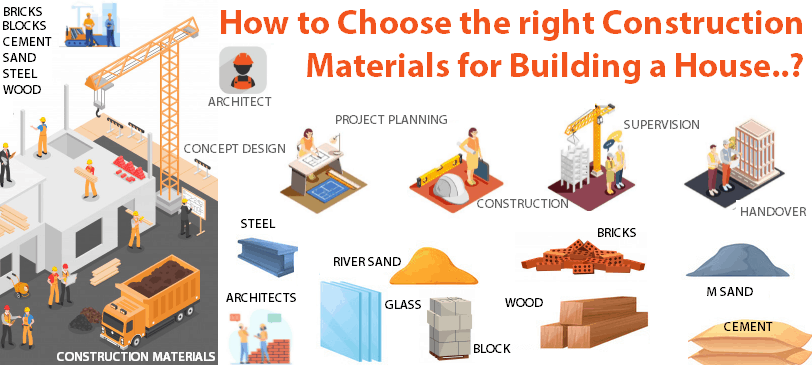Choosing the best material to build a house with is a multifaceted decision, influenced by factors ranging from budget and climate to personal aesthetics and environmental concerns. The options available are vast, each presenting its own unique set of advantages and disadvantages. Selecting the optimal material involves careful consideration of long-term costs, maintenance requirements, and the overall desired style and functionality of the home. To determine what is the best material to build a house with, one must delve into the details of each option, weighing the pros and cons against their specific needs and priorities.
Exploring Common Building Materials
The construction industry boasts a wide array of materials, each with its own distinct characteristics. Let’s examine some of the most prevalent choices:
- Wood: A traditional and readily available option, wood offers excellent insulation and a natural aesthetic. However, it’s susceptible to pests, fire, and moisture damage.
- Concrete: Known for its durability and resistance to fire and pests, concrete provides a solid and long-lasting structure. However, it can be less energy-efficient than other materials.
- Brick: A classic and aesthetically pleasing choice, brick offers excellent fire resistance and durability. However, it can be relatively expensive.
- Steel: Strong and durable, steel offers excellent resistance to earthquakes and other natural disasters. However, it’s susceptible to rust and can be more expensive than other materials.
- Straw Bale: An eco-friendly option, straw bale construction offers excellent insulation and a unique aesthetic. However, it requires specialized construction techniques.
Factors to Consider When Choosing a Material
Before settling on a material, consider the following factors:
Climate
The climate in your region will significantly impact the performance of different building materials. For example, wood may not be the best choice in humid climates due to its susceptibility to moisture damage. Consider materials that are well-suited to your local weather conditions.
Budget
The cost of materials can vary widely. Establish a budget and research materials that fit within your financial constraints. Remember to factor in not just the cost of the raw materials, but also the cost of labor, installation, and ongoing maintenance.
Sustainability
If environmental concerns are a priority, consider using sustainable building materials such as reclaimed wood, recycled steel, or straw bales. These options can help reduce your carbon footprint and promote environmentally responsible construction.
Maintenance
Different materials require different levels of maintenance. Some materials, like brick, are relatively low-maintenance, while others, like wood, require regular painting or staining to protect them from the elements. Consider the long-term maintenance requirements of each material before making a decision.
Comparative Table of Building Materials
| Material | Pros | Cons |
|---|---|---|
| Wood | Good insulation, natural aesthetic | Susceptible to pests, fire, and moisture |
| Concrete | Durable, fire and pest resistant | Less energy-efficient |
| Brick | Fire resistant, durable, aesthetically pleasing | Relatively expensive |
| Steel | Strong, earthquake resistant | Susceptible to rust, can be expensive |
| Straw Bale | Eco-friendly, excellent insulation | Requires specialized construction |
Ultimately, the decision of what is the best material to build a house with is a personal one. It depends on a variety of factors, including your budget, climate, aesthetic preferences, and environmental concerns. Carefully consider all of these factors before making a decision that you will be happy with for years to come.
ADVANCED MATERIAL OPTIONS AND EMERGING TECHNOLOGIES
Beyond the commonly employed materials, several advanced options and emerging technologies warrant consideration for discerning homeowners. These innovations often prioritize sustainability, energy efficiency, and enhanced structural performance.
– Cross-Laminated Timber (CLT): This engineered wood product boasts exceptional strength and stability, rivaling concrete and steel in certain applications. CLT offers a sustainable alternative with superior thermal performance and reduced construction time.
– Insulated Concrete Forms (ICFs): These interlocking modular units provide both structural support and insulation in a single step. ICF construction results in highly energy-efficient homes with excellent soundproofing qualities.
– Structural Insulated Panels (SIPs): SIPs consist of an insulating foam core sandwiched between two structural facings, typically oriented strand board (OSB). This system offers rapid construction, superior insulation, and reduced air infiltration.
– Aerated Autoclaved Concrete (AAC): A lightweight concrete alternative, AAC offers excellent thermal insulation, fire resistance, and sound absorption. Its porous structure reduces weight and enhances workability.
THE FUTURE OF BUILDING MATERIALS
Ongoing research and development are continually yielding new and innovative building materials. Self-healing concrete, which incorporates bacteria to repair cracks, promises increased durability and reduced maintenance. Bio-based materials, such as mycelium composites and hempcrete, offer sustainable alternatives with minimal environmental impact. Nanomaterials are also being explored to enhance the properties of existing materials, improving strength, durability, and energy efficiency.
A SYSTEMS-BASED APPROACH TO MATERIAL SELECTION
Rather than viewing building materials in isolation, a systems-based approach considers the interplay between different components and their overall impact on the building’s performance. This holistic perspective takes into account factors such as energy consumption, water usage, indoor air quality, and waste generation. By optimizing the entire building system, homeowners can achieve greater sustainability, comfort, and long-term value.
INTEGRATING DESIGN AND MATERIALITY
The selection of building materials should be intrinsically linked to the overall design of the home. Architects and designers play a crucial role in specifying materials that complement the architectural style, enhance the building’s aesthetic appeal, and optimize its functionality. Thoughtful integration of design and materiality ensures a cohesive and harmonious outcome.
In conclusion, the ultimate selection of building materials necessitates a comprehensive evaluation of diverse factors, ranging from financial constraints and climatic conditions to sustainability considerations and aesthetic preferences. Employing a systems-based methodology, coupled with adept architectural design, allows for the construction of dwellings that are not only structurally sound and aesthetically pleasing but also environmentally responsible and economically viable. It is crucial to prioritize a well-informed decision-making process to ascertain what truly embodies the best material to build a house with, aligning with individual needs and contributing to a more sustainable built environment.







